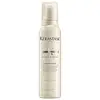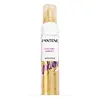What's inside
What's inside
 Key Ingredients
Key Ingredients

No key ingredients
 Benefits
Benefits

 Concerns
Concerns

 Ingredients Side-by-side
Ingredients Side-by-side

Water
Skin ConditioningIsobutane
Propylene Glycol
HumectantPolyquaternium-4
Butane
Propane
PEG-40 Hydrogenated Castor Oil
EmulsifyingPhenoxyethanol
PreservativeLaureth-4
EmulsifyingCaprylyl Glycol
EmollientCalcium Pantothenate
Ethylhexyl Methoxycinnamate
UV AbsorberSafflower Glucoside
Arginine
MaskingGlutamic Acid
HumectantCetrimonium Chloride
AntimicrobialSerine
MaskingHexyl Cinnamal
PerfumingHydroxypropyltrimonium Hydrolyzed Wheat Protein
Skin ConditioningLinalool
PerfumingCitronellol
PerfumingAlpha-Isomethyl Ionone
PerfumingSodium Hyaluronate
Humectant2-Oleamido-1,3-Octadecanediol
Skin ConditioningGeraniol
PerfumingParfum
MaskingWater, Isobutane, Propylene Glycol, Polyquaternium-4, Butane, Propane, PEG-40 Hydrogenated Castor Oil, Phenoxyethanol, Laureth-4, Caprylyl Glycol, Calcium Pantothenate, Ethylhexyl Methoxycinnamate, Safflower Glucoside, Arginine, Glutamic Acid, Cetrimonium Chloride, Serine, Hexyl Cinnamal, Hydroxypropyltrimonium Hydrolyzed Wheat Protein, Linalool, Citronellol, Alpha-Isomethyl Ionone, Sodium Hyaluronate, 2-Oleamido-1,3-Octadecanediol, Geraniol, Parfum
Water
Skin ConditioningPropane
Butane
Polyquaternium-4
Isobutane
Pvp
Emulsion StabilisingVp/Va Copolymer
Phenoxyethanol
PreservativeChitosan
Polyquaternium-16
Parfum
MaskingLaureth-4
EmulsifyingDisodium EDTA
Formic Acid
PreservativeCetrimonium Chloride
AntimicrobialMethylparaben
PreservativeHistidine
HumectantCaprylyl Glycol
Emollient1,2-Hexanediol
Skin ConditioningPanthenol
Skin ConditioningHexyl Cinnamal
PerfumingPanthenyl Ethyl Ether
Ingredients Explained
These ingredients are found in both products.
Ingredients higher up in an ingredient list are typically present in a larger amount.
Butane is a gas derived from petroleum and natural gas. It is used as an aerosol propellant.
Caprylyl Glycol is a humectant and emollient, meaning it attracts and preserves moisture.
It is a common ingredient in many products, especially those designed to hydrate skin. The primary benefits are retaining moisture, skin softening, and promoting a healthy skin barrier.
Though Caprylyl Glycol is an alcohol derived from fatty acids, it is not the kind that can dry out skin.
This ingredient is also used as a preservative to extend the life of products. It has slight antimicrobial properties.
Learn more about Caprylyl GlycolThis ingredient is a preservative, antimicrobial, and emulsifier. It is often used in cosmetics for its ability to cleanse, condition, and reduce static.
Cetrimonium chloride is a quaternary ammonium salt, meaning it has a water-soluble structure.
Hexyl Cinnamal is a fragrance ingredient with a similar scent to jasmine. It can be naturally found in chamomile essential oil.
This ingredient is a known EU allergen and may sensitize the skin. The EU requires this ingredient to be listed separately on an ingredients list.
Hexyl Cinnamal is not water soluble but is soluble in oils.
Learn more about Hexyl CinnamalWe don't have a description for Isobutane yet.
Laureth-4 is created by reacting ethylene oxide with Lauryl Alcohol. It is a surfactant and emulsifier.
Surfactants reduce the surface tension of ingredients so they can mix better. Emulsifiers prevent ingredients such as oil and water from separating.
Parfum is a catch-all term for an ingredient or more that is used to give a scent to products.
Also called "fragrance", this ingredient can be a blend of hundreds of chemicals or plant oils. This means every product with "fragrance" or "parfum" in the ingredients list is a different mixture.
For instance, Habanolide is a proprietary trade name for a specific aroma chemical. When used as a fragrance ingredient in cosmetics, most aroma chemicals fall under the broad labeling category of “FRAGRANCE” or “PARFUM” according to EU and US regulations.
The term 'parfum' or 'fragrance' is not regulated in many countries. In many cases, it is up to the brand to define this term.
For instance, many brands choose to label themselves as "fragrance-free" because they are not using synthetic fragrances. However, their products may still contain ingredients such as essential oils that are considered a fragrance by INCI standards.
One example is Calendula flower extract. Calendula is an essential oil that still imparts a scent or 'fragrance'.
Depending on the blend, the ingredients in the mixture can cause allergies and sensitivities on the skin. Some ingredients that are known EU allergens include linalool and citronellol.
Parfum can also be used to mask or cover an unpleasant scent.
The bottom line is: not all fragrances/parfum/ingredients are created equally. If you are worried about fragrances, we recommend taking a closer look at an ingredient. And of course, we always recommend speaking with a professional.
Learn more about ParfumPhenoxyethanol is a preservative that has germicide, antimicrobial, and aromatic properties. Studies show that phenoxyethanol can prevent microbial growth. By itself, it has a scent that is similar to that of a rose.
It's often used in formulations along with Caprylyl Glycol to preserve the shelf life of products.
We don't have a description for Polyquaternium-4 yet.
Propane is a gas derived from petroleum and natural gas. It is used as a propellant.
This ingredient is most commonly used in shaving cream, hair products, and makeup.
Water. It's the most common cosmetic ingredient of all. You'll usually see it at the top of ingredient lists, meaning that it makes up the largest part of the product.
So why is it so popular? Water most often acts as a solvent - this means that it helps dissolve other ingredients into the formulation.
You'll also recognize water as that liquid we all need to stay alive. If you see this, drink a glass of water. Stay hydrated!
Learn more about Water